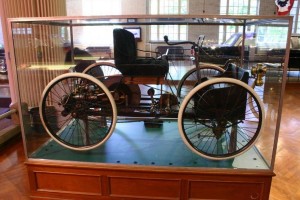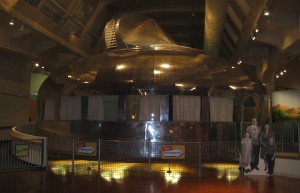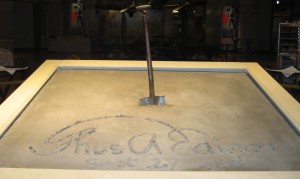Entrepreneurial tourism… It is definitely worth flying to Detroit to spend one or two days at The Henry Ford Museum and Greenfield Village in Dearborn. It is the largest estate dedicated to the history of American lifestyles and technology innovations – and it also includes a high school! Originally called the Edison Institute of Technology and Greenfield Village (celebrating 50 years of the electric light in 1929), the organization spun off from the Ford Motor Company after the death of Henry Ford in 1947. It is a Non-for-Profit-Organization efficiently managed as a one-of-a-kind intellectual “resort” (also offering great food) by Patricia Mooradian.
I was lucky enough to walk through part of the Museum with Patricia and Marc Greuther, the Curator of Industry and Design (he simply knows everything!). Every step of the way, I was thinking that the only “entrepreneurial tourism” most entrepreneurs really know only takes them to a limited number of hot spots, such as Silicon Valley or Boston, and this mostly for practical purposes. Yet, there are many more places able to give aspiring entrepreneurs the opportunity to think about what entrepreneurship and innovation are about, reflect over the lives of some predecessors, even when they may not be directly related to their field. The Henry Ford Museum is definitely such a place — and would be a great alternative to most of the impersonal resorts that host high-tech conferences. Where else can you see dozens of authentic structures such as the home of Noah Webster, who wrote the first American dictionary, or Thomas Edison’s lab in Menlo Park (NJ)?
A non-linear history of innovation… Most entrepreneurs want to be innovators, i.e. produce value by making a meaningful difference in the lives of people. Where do they start? Do they wake up one day with the idea of the century with “Eureka!” on their lips? No. Most innovations start in silence and actually reach their epiphanic status at the end of a frequently complicated road, and after the ups and downs of trials and errors. One of the big plusses of The Henry Ford is that it features the non-linear history of innovation remarkably. Henry Ford literally stockpiled things he loved, and the beauty of the Museum is that curators over time did not try to impose the artificial logic of chronology. I love the fact that the oldest surviving steam engine in the world (created in the early eighteenth century by Thomas Newcomen to pump water out of a deep mine in England) is simply yards away from a 1931 Bugatti Royale — and that nobody in charge of this fabulous venue tried to reduce the exuberance of innovation along a simplistic time-line of progress. The important thing here is that both “engines” were part of Ford’s personal world. He had operated the Westinghouse portable steam engine at his parents’ farm and was later hired by the Westinghouse company to service their steam engines.
 Disruptiveness is a group phenomenon, lest it’s art… Created by Henry Ford at the peak of his success, the museum is a tribute to Thomas Edison — whom the young Ford idolized. For Henry Ford, working in 1891 as an engineer with the Edison Illuminating Company was as extraordinary as being hired at Apple is for a programmer. Just imagine the pride of the young man as he was introduced to Edison at a company-sponsored convention in Manhattan Beach, New York in 1896 “as a young fellow who has made a gas car.” At the age of 32, Ford had created this first car, the Ford Quadricycle, which he sold for $200 in 1896 to a Detroit resident, Charles Ainsley (and bought it back a few years later). Looking at the vehicle in the museum, I realized that automobile creators had to overcome people’s fascination with bicycles as much as they had to move away from the “horseless” carriage in order to actually create what we know now as a modern automobile. It was no less interesting to look at what Benz was doing at the exact same time – and know that Ford was just as harsh about this competitor on exhibition at Macy’s store in New York in 1895 as any high-tech entrepreneur today. Innovation is disruptive, that’s true, but primarily in the sense that it outdates existing patterns and concepts through an often chaotic process, and no entrepreneur should claim to be alone in such ability to disrupt thinking-as-usual. In fact, “disruptiveness” is often an after-the-fact statement by people who either don’t know or want to ignore all intermediate iterations.
Disruptiveness is a group phenomenon, lest it’s art… Created by Henry Ford at the peak of his success, the museum is a tribute to Thomas Edison — whom the young Ford idolized. For Henry Ford, working in 1891 as an engineer with the Edison Illuminating Company was as extraordinary as being hired at Apple is for a programmer. Just imagine the pride of the young man as he was introduced to Edison at a company-sponsored convention in Manhattan Beach, New York in 1896 “as a young fellow who has made a gas car.” At the age of 32, Ford had created this first car, the Ford Quadricycle, which he sold for $200 in 1896 to a Detroit resident, Charles Ainsley (and bought it back a few years later). Looking at the vehicle in the museum, I realized that automobile creators had to overcome people’s fascination with bicycles as much as they had to move away from the “horseless” carriage in order to actually create what we know now as a modern automobile. It was no less interesting to look at what Benz was doing at the exact same time – and know that Ford was just as harsh about this competitor on exhibition at Macy’s store in New York in 1895 as any high-tech entrepreneur today. Innovation is disruptive, that’s true, but primarily in the sense that it outdates existing patterns and concepts through an often chaotic process, and no entrepreneur should claim to be alone in such ability to disrupt thinking-as-usual. In fact, “disruptiveness” is often an after-the-fact statement by people who either don’t know or want to ignore all intermediate iterations.
 As you walk through the museum, you realize that innovators that meet market success come in droves at any given time in any given genre (even if some are more successful than others). Solitarily disruptive innovators often fail – and may unwittingly join the ranks of artists. One of the most magnificent disruptive dead ends of the museum is the Buckminster Fuller’s Dymaxion house – packed with revolutionary ideas, but now a piece of modern art.
As you walk through the museum, you realize that innovators that meet market success come in droves at any given time in any given genre (even if some are more successful than others). Solitarily disruptive innovators often fail – and may unwittingly join the ranks of artists. One of the most magnificent disruptive dead ends of the museum is the Buckminster Fuller’s Dymaxion house – packed with revolutionary ideas, but now a piece of modern art.
 And it all comes back to the some mythical and recurring beginning … I liked the entrance/exit of the museum. On September 27, 1928, Thomas Edison thrust a shovel once used by Luther Burbank (1849-1926), one of the most creative American botanist and horticulturist, into a freshly poured concrete block and signed his name on the site of the planned museum building (modeled after Independence Hall in Philadelphia). Speak of a syncretistic view of America – as well as a key feature of innovation, i.e. the ability to integrate artifacts in both nature and society.
And it all comes back to the some mythical and recurring beginning … I liked the entrance/exit of the museum. On September 27, 1928, Thomas Edison thrust a shovel once used by Luther Burbank (1849-1926), one of the most creative American botanist and horticulturist, into a freshly poured concrete block and signed his name on the site of the planned museum building (modeled after Independence Hall in Philadelphia). Speak of a syncretistic view of America – as well as a key feature of innovation, i.e. the ability to integrate artifacts in both nature and society.
Marylene Delbourg-Delphis
More information about the Henry Ford Museum and the Village (description & services): http://www.hfmgv.org/ and the stores: http://www.thehenryford.org/shop/index.aspx
About Patricia Mooradian: http://www.metromodemedia.com/blogs/bloggers/PatriciaMooradian0067.aspx; http://www.culturalalliancesemi.org/index.php?option=com_content&task=view&id=59&Itemid=0
About Marc Greuther: http://innovatorsroadtrip.com/2009/03/j-marc-greuther-curator-of-the-henry-ford-museum/
You may also want to take a look at Henry Ford’s autobiography: My Life and Work – An Autobiography of Henry Ford


3 responses so far ↓
1 Henery Schaffer // Sep 28, 2009 at 2:55 pm
A friend of mine just emailed me one of your articles from a while back. I read that one a few more. Really enjoy your blog. Thanks
2 The Daily Reviewer // Sep 30, 2009 at 5:53 pm
Hi!
Congratulations! Your readers have submitted and voted for your blog at The Daily Reviewer. We compiled an exclusive list of the Top 100 start-ups Blogs, and we are glad to let you know that your blog was included! You can see it at http://thedailyreviewer.com/top/startups/4
You can claim your Top 100 Blogs Award here : http://thedailyreviewer.com/pages/badges/startups
P.S. This is a one-time notice to let you know your blog was included in one of our Top 100 Blog categories. You might get notices if you are listed in two or more categories.
P.P.S. If for some reason you want your blog removed from our list, just send an email to angelina@thedailyreviewer.com with the subject line “REMOVE” and the link to your blog in the body of the message.
Cheers!
Angelina Mizaki
Selection Committee President
The Daily Reviewer
http://thedailyreviewer.com
3 Dave Ferguson // Oct 13, 2009 at 9:07 am
I’m delighted to have discovered your blog. I grew up in Detroit and have visited both the Museum and Greenfield Village many times.
In 1929, the Museum had a special event to mark the anniversary of the electric light and show off the recreation of Edison’s Menlo Park lab. Ford supposedly asked, “Could you do it again?” Together with an assistant, Edison sat down — “It was never this tidy,” he said — and “reinvented” the incandescent light. (See the museum’s photo.)
Leave a Comment